TAVR Beats Out SAVR, at Least In-Hospital, for Patients With Prior CABG
Prior CABG may actually put patients at higher surgical risk, one expert speculates, making TAVR the better option in this group.

Denver, CO—Transcatheter aortic valve replacement appears to be better option than surgical aortic valve replacement (SAVR) for patients who have already undergone CABG, according to new data presented during a moderated poster session last week at TCT 2017.
SAVR and TAVR yielded similar in-hospital mortality results, investigators found. However, patients treated with TAVR had lower risks of stroke, acute kidney injury, MI, and major bleeding.
Commenting on the research for TCTMD, John Lasala MD, PhD (Barnes Jewish Hospital, St. Louis, MO), said, “I think it’s very interesting. It really underscores the fact that once you’ve got a prior bypass, it really puts you in a completely different league.”
The research implies that “all of the event rates that take place with a subsequent surgery, like a repeat chest surgical intervention are accentuated, and that a TAVR can reduce some of those although they are still slightly higher for someone who didn’t have prior CABG,” noted Lasala, who moderated the session.
Tanush Gupta, MD (Montefiore Medical Center, Bronx, NY), lead author of the study, noted that use of TAVR in previous-CABG patients has increased dramatically over the years. “In the last quarter of 2014, TAVR was being used in approximately 70% of the patients with prior CABG,” he reported. “The relative use of TAVR also increased in patients without prior CABG, but the use was much higher in patients with prior CABG.”
Gupta et al used National Inpatient Sample data from 2012 to 2014, focusing specifically on the 147,395 adult patients who underwent isolated AVR. They then then compared in-hospital outcomes between groups, noting several important differences.
In-Hospital Outcomes
|
|
SAVR |
TAVR |
OR (95% CI) |
P Value |
|
In-Hospital Mortality |
2.4% |
2.3% |
1.06 (0.79-1.42) |
0.71 |
|
Myocardial Infarction |
3.4% |
1.5% |
0.45 (0.33-0.62) |
< 0.001 |
|
Stroke |
2.6% |
1.4% |
0.54 (0.39-0.76) |
< 0.001 |
|
Major Bleeding |
24.6% |
10.6% |
0.36 (0.32-0.41) |
< 0.001 |
|
Vascular Complications |
5.4% |
5.5% |
1.03 (0.84-1.25) |
0.80 |
|
AKI |
19.3% |
16.2% |
0.81 (0.72-0.91) |
< 0.001 |
|
AKI Requiring Dialysis |
1.2% |
1.2% |
1.00 (0.66-1.52) |
1.00 |
|
Permanent Pacemaker |
5.4% |
8.9% |
1.71 (1.43-2.04) |
< 0.001 |
|
Length of Stay, Days |
9.1 ± 6.0 |
6.6 ± 5.1 |
0.73 (0.71-0.74) |
< 0.001 |
Looking at the study results, Lasala observed that almost across the board the findings consistently favored TAVR for the key study endpoints. Moreover, he said, “these people are feeling better early on and are more likely to go home rather than to an extended nursing facility or something like that. “
For Lasala, the lack of difference in vascular complications is particularly reassuring. “We don’t usually see a parity with vascular complications, and I think that’s a surprise,” he said. “People associate TAVR with a higher complication rate vascularly, but I think we have gotten better over the years.”
Gupta and his colleagues conclude that there is “increasing use of TAVR over SAVR as the preferred modality of AVR in patients with prior CABG.”
In terms of next steps, Gupta said he hopes to see additional analyses of more recent aortic valve replacement trials, looking more specifically at long-term outcomes of TAVR and SAVR in patients with prior CABG. This can “easily” be done using existing databases, he suggested.
Ashley Lyles is the 2017 recipient of the Jason Kahn Fellowship in Medical Journalism. She is currently a graduate student…
Read Full BioSources
Gupta T. Transcatheter vs surgical aortic valve replacement in patients with prior coronary artery bypass grafting: trends in utilization and a propensity-score matched analysis of in-hospital outcomes. Presented at: TCT 2017. October 31, 2017. Denver, CO.
Disclosures
- Gupta reports no relevant conflicts of interest.


Comments